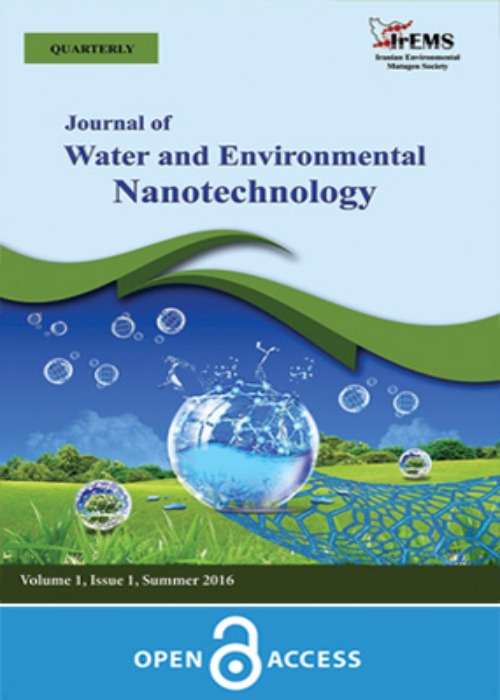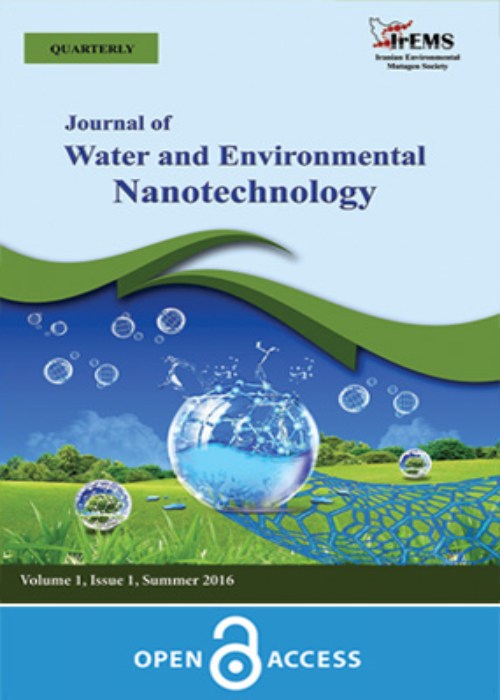فهرست مطالب

Journal of Water and Environmental Nanotechnology
Volume:8 Issue: 4, Autumn 2023
- تاریخ انتشار: 1402/08/10
- تعداد عناوین: 8
-
-
Pages 320-333Landfill leachate is the fluid percolating through the landfill and is one of the most important environmental challenges that lead to the contamination of water and soil resources. In this study, magnetic graphene oxide nanoparticles with WO3 (GO-Fe3O4/WO3) were synthesized through the hydrothermal method to eliminate chemical oxygen demand (COD) from leachate. The obtained products were characterized using X-ray diffraction (XRD), Fourier Transform Infrared Spectroscopy (FTIR), Scanning Electron Microscopy (SEM), Thermogravimetric analysis (TGA), and Vibrating sample magnetometer (VSM) analysis. The influence of various operating parameters, such as initial solution pH, adsorbent dosage, contact time, and temperature, on COD removal was studied. Additionally, kinetic, isotherm, and thermodynamic studies were conducted to evaluate the adsorption capacity of the adsorbent. The results revealed that the maximum adsorption capacity of GO-Fe3O4/WO3 was 2500 mg/g adsorbent at pH 4, a contact time of 90 minutes, an adsorbent dosage of 25 mg g-1, and a temperature below 298 K, respectively. According to the adsorption kinetic fitting results, the experimental adsorption data were well described by the pseudo-second order kinetic with an R2 value of 0.97, and the Freundlich isotherm equation with an R2 value of 0.99. The thermodynamic results indicated that the adsorption was spontaneous and exothermic for COD adsorption. In general, the adsorption process of the synthesized GO-Fe3O4/WO3 nanocomposite revealed that it is highly effective for landfill leachate treatment and has great practical value in leachate treatment.Keywords: Adsorption isotherms, COD, GO-Fe3O4, WO3, kinetic, Landfill Leachate
-
Pages 334-356The present study features the synthesis of Dodecylbenzene sulphonic acid-doped polypyrrole tungsten oxide (PPy-WO3) nanocomposites and its photocatalyic studies on Methylene Blue (MB). The nanocomposites of PPy with a very low concentration of WO3 were prepared using 0.05 to 0.3 wt.%, of WO3 nanoparticles. The composites were characterized by using-ray Diffraction, FTIR and FESEM for phase identification, morphological studies. The electrical conduction of the nanostructured materials at room temperature exceeded that of PPy, with the electrical conductivity increasing linearly with higher WO3 concentrations. The band gap for the nanocomposite was found to be 2.12eV. The PL spectra substantiated the adequate segregation of charge carriers photoexcited in the samples. The nanocomposites were tested as photocatalysts for the degradation of methylene blue dye (MB). A two-step mechanism has been propsed for dye removal: adsorption (in the absence of UV light) and photodegradation on the photocatalyst surface (in the presence of UV light). The maximum removal efficiency for methylene blue dye was 98.31% in UV light for 0.16 g/L of the 0.3 wt.% PPy- WO3 nanocomposite, with a dye concentration of 5 mg/L. The addition of p-benzoquinone (*O2- scavenger) contributed to a significant decrease in the photodegradation efficiency of the catalyst, i.e.,63.21%, and thus can be believed as the main active species for the degradation of the methylene blue dye.Keywords: Polypyrrole, Tungsten oxide, DBSA, Photocatalysis, Adsorption
-
Pages 357-368Heavy metal ions, such as As (III) and Pb (II), are harmful even at trace levels and have caused series health effects on living beings. Therefore, removing these heavy metal ions from the aqueous environment is highly desirable. In this study, Mg0.33Ni0.33Co0.33SmxFe2-xO4 nanoparticles, where x = 0.00, 0.01, 0.02, 0.04 and 0.08, were synthesized by the co-precipitation method and characterized using X-Ray Diffraction (XRD), Transmission Electron Microscopy (TEM) and UV-Vis spectroscopy techniques in order to study the structural and optical properties. The prepared nanoparticles were applied as adsorbents for the removal of As (III) and Pb (II) from wastewater. Among the prepared samples, Mg0.33Ni0.33Co0.33SmxFe2-xO4 nanoparticles with x = 0.04 and 0.08 exhibited improved adsorption performance where As (III) was totally removed after 90 min. The experimental adsorption data of As (III) was well fitted with a second-order kinetics model and Langmuir isotherm. Furthermore, the highest removal % of Pb (II) was revealed by Mg0.33Ni0.33Co0.33SmxFe2-xO4 nanoparticles with x = 0.01. Thus, doping Mg0.33Ni0.33Co0.33Fe2O4 with Sm improved the adsorption performance of nanoparticles for the removal of As (III) more than that of Pb (II).Keywords: Spinel ferrite nanoparticles, Heavy metals ions removal, As (III), Pb (II), second-order kinetics, Langmuir adsorption isotherm
-
Pages 369-383Here we report a simple and eco-friendly solvothermal synthesis of graphitic carbon nitride nanospheres (g-CNNS) at 180 oC. The synthesized g-CNNS is characterized by various analytical techniques such as FESEM, PXRD, BET isotherm, Zeta potential, EDX and FT-IR spectroscopy. The adsorption property of g-CNNS is studied using four different dyes in aqueous medium and found that g-CNNS is an efficient material for cationic dye adsorption. A Comprehensive investigation of the kinetics, isotherms and thermodynamics of methylene blue (MB) adsorption, is carried out. The adsorption of MB on g-CNNS is well described by Langmuir isotherm model, and the experimental data fits well with pseudo-second order kinetics. The high rate of adsorption (94.92% MB removal in 120 minute at neutral pH) is attributed to electrostatic interaction between negative charged g-CNNS and cationic organic dye molecule. Additionally, g-CNNS demonstrated good reusability, retaining its efficiency for at least three cycles. Over all our findings suggests that g-CNNS has potential as an efficient adsorbent for wastewater treatment.Keywords: Carbon nitride, Nanosphere, Adsorption, Methylene blue, Cationic dye
-
Pages 384-395The Beni Saf Water Company (BWC) desalination plant in Ain Témouchent (Algeria) uses reverse osmosis technique. This process, which is based on dense membranes operating at high pressure, produces a permeate with characteristics that exceeds the necessary requirements. However, the Reverse Osmosis (RO) technique suffers from the following limitations: high energy consumption, low water recovery and excessive fouling of membranes. We conducted this work to contribute to the study of seawater desalination by introducing another system such as Nanofiltration (NF) to reduce energy consumption and retard the fouling of RO membranes. This research study is focused on the installation of Nanofiltration membranes to desalinate seawater with a salinity of about 35mg/L, in order to protect RO membranes and reduce their fouling. NF was found to be effective for partial and selective desalination of the studied seawater in single or two stages, with lower energy consumption than RO. The ESNA1-LF-LD Nanofiltration membrane is more suitable and competitive compared to SWC4-LD for seawater desalination with a 99% removal rate of multivalent ions. It allows for partial desalination and also allows for the preparation of water for industrial use (cooling....) at twice the pressure and at higher conversion rates (90%). These characteristics provide system designers with new options to reduce the capital cost of the system as well as the operating costs.Keywords: Desalination, Reverse osmosis, Nanofiltration, Sea water, Fouling
-
Pages 396-405
This study investigated the removal of methylene blue dye from aqueous solutions using Mg solid state exchanged bentonite. Parent bentonite and magnesium exchanged bentonite were characterized by scanning electron microscopy (SEM), X-ray diffraction (XRD), Brunauer Emmett Teller (BET), Energy dispersive X-ray spectroscopy (EDX), and Fourier transform infrared spectroscopy (FTIR). The parent bentonite showed the lowest removal efficiency (40.3%) and prepared magnesium exchanged bentonite for 10 min showed the highest removal efficiency (54.8%). Thus, dye absorption by modified bentonite increased compared to parent bentonite. After its modification by the ion exchange method, the specific surface was changed from 44.5 to 56.05 M2/g. EDX results indicate that the cation exchange process has been completed successfully. Ion exchange causes some minor changes in bentonite morphology and crystallinity. The best conditions for removing methylene blue using magnesium exchanged bentonite was pH 10, adsorbent dosage 0.05 mg/liter, initial concentration of solution 100 mg per liter, and contact time of 120 minutes with a Removal efficiency of 96.67. The Langmuir isotherm had a better correlation coefficient than the Freundlich adsorption model, which indicated the homogeneous surface of the adsorbent.
Keywords: Adsorption, Magnesium, Solid state exchange, Bentonite -
Pages 406-416In the present work, truncated octahedron and octahedron shaped Cu2O and Cu2O/TiO2-QD composite have been synthesized using precipitation method and used as a photocatalyst. Synthesized material was characterized by using various analytical techniques- XRD, SEM, TEM and UV-Visible DRS. TEM images clearly shows that the TiO2 was highly dispersed and firmly anchored on single crystals of copper oxide in Cu2O/TiO2-QD composite and also confirmed the truncated octahedron and octahedron shapes of copper oxide. The excellent performance of synthesized Cu2O/TiO2-QD photocatalyst has been proved the maximum degradation (89.00%) of Congo red dye at pH=6. The effect of various parameters in the dye degradation such as influence of pH, amount of photocatalyst, concentration of dye and reusability of the photocatalyst has been studied. The highest degradation rate was found with concentration of Congo red dye 9 mg/L, 150mg/L of Cu2O/TiO2-QD, and 110 min. Thus, the photocatalytic performance of Cu2O/TiO2-QD composite revealed the excellent and effective degradation of Congo-red dye.Keywords: Capping agent, Photoexcitation, Photocatalysis, Truncated octahedron
-
Pages 417-441In the present studies, cytotoxicity evaluation of camphor-mediated bimetallic nanoparticles has been done. The IC50 value of Te combined Se, Zr, and Ce bimetallic nanoparticles are 18.0, 16.0, 175.4,38.9 µg/ml respectively. A maximum proportion of cell activity attained at 16 µg/ml reveals the size-dependent anticancer property of TeSe, Tezr, and TeCe BNPs towards the MCF -7 Cell line and SeZr towards skin cancer cell lines. The surface morphology with particle size and optical attribute of camphor-mediated BNPs can be analyzed by various studies such as Uv- visible spectroscopy, XRD, AFM, SEM –EDX, HR-TEM, and XPS study the size of the SeZr BNPs was observed to less than 100 nm, which conforms to the bioactive nature of bimetallic nanoparticles. In addition, the photocatalytic behaviour of camphor-mediated SeZr BNPs has been tested by using methylene blue dye under natural sunlight and UV illumination. Hence, the result of the studies shows a maximum of 87% degradation within 60 min for same concentration solution at PH 9 which can be due to increases in hydroxyl ion concentration. Further, a comparative study in catalytic activity on photo degradation of MB dye with an optimized sample was carried out under UV irradiation. The reusability test was performed after 60 min degradation, implying the Photocatalyst’s stability. Further, pseudo -first- order kinetic model was performed for obtained data. This is the first report on catalytic degradation using camphor-mediated SeZr BNPs to effective removal of pollutants in waste water streamsKeywords: Methylene blue, Eugenol, Cinnamaldehyde, docking activities, skin cancer cell lines


